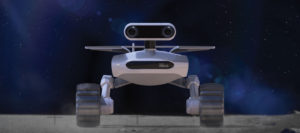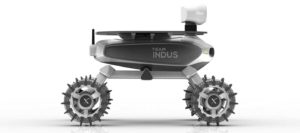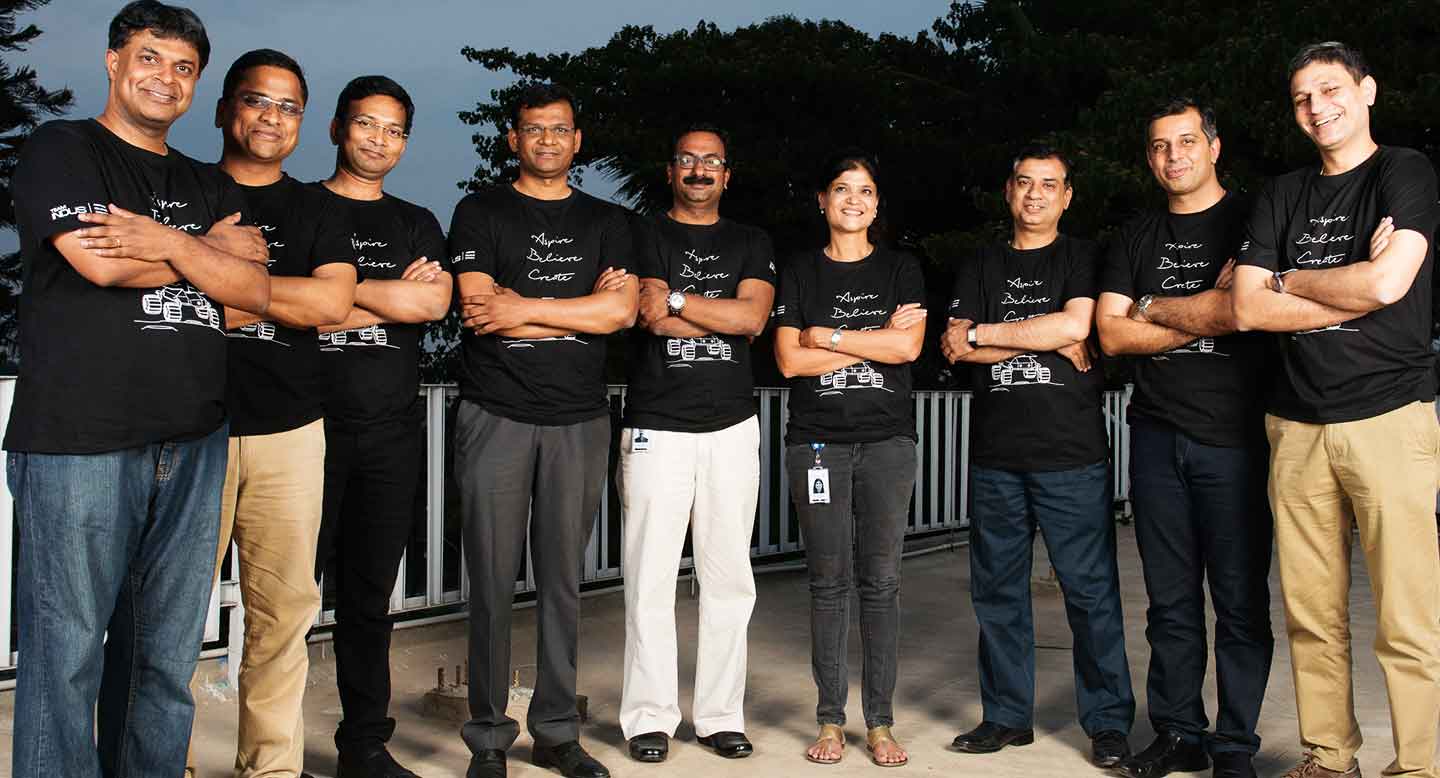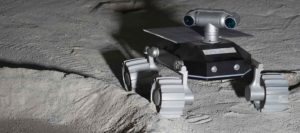When Nandan Nilekani invested in TeamIndus, he did so simply because he thought the work and progress made by them would serve as an inspiration to young achievers and innovators for generations to come. Here, we chronicle the TeamIndus journey till date through an interview with its key team member; Rahul Narayan.

If you hear the story of Nirmal Suraj Gadde, the first employee at TeamIndus, and the founding team’s narration of their last minute entry into the Google Lunar XPrize (GLXP), you can’t help but find a semblance between the two journeys; one we call, a single-minded zeal.
It’s no wonder that, despite operating on a slender budget and engineering a lander and rover with a team half the size of any others’, TeamIndus has put India on the global map by gracefully crossing GLXP’s first Milestone (Prize) in 2013, and now nurturing its 100-member team to compete against four other contenders; Israel’s SpaceIL, Florida’s Moon Express, an international team known as Synergy Moon, and Japan’s Hakuto, to fulfil its final moon mission.
But wait, this is not a yet another piece elaborating on the entrepreneurial journey of the team. Certainly not. Instead, some questions which constantly irked our minds were; how did its founding members, Rahul Narayan, Indranil Chakraborty (the only member with an aerospace background), Sameer Joshi, Julius Amrit and Dilip Chabria sign up for nothing short of a moon mission with nominal understanding of space technology? What was year one at TeamIndus like? How are investors reacting to placing bets on a mission which may or may not succeed? And finally, what happens to the 100-member team after the final launch in December 2017?
We set out to find the answers.
An Accidental Entry
Although it seems like a gargantuan mission to land a rover on the moon, Narayan, the TeamIndus co-founder and lead, simply states that they accidentally landed on GLXP when they were searching for interesting technology challenges to take up back in 2011. “When we decided to enter GLXP, there were 20-odd teams, globally, which were creating something inspirational as a part of the mission. Some were experts and some were ordinary people. Imagine so many people attempting to fulfil a single mission, albeit through multiple means,” he recalls. A message that the duo took away was; when common people across the globe can attempt it, why not someone from India? While the US $ 50,000 registration fee made it no economical affair, that was reason enough for them to give it a shot. “We began by asking ourselves a vital question; where should we pick up, to solve such a complex problem?” narrates Narayan.
It was a chance meeting; we sent a mail and he agreed to meet us. Later, he would help us with technology inputs whenever possible. He also introduced us to other ISRO scientists
On meeting one of the first experts TeamIndus reached out to; Dr. Krishnaswamy Kasturirangan, Former Chairman of ISRO and Former Member of Indian Parliament (Rayja Sabha)
The First, Crucial Year
Even before putting a blueprint in place, the first challenge TeamIndus had to deal with was the prejudice and limitation of being a team competing out of India. For example, Narayan admits that they always knew they have to struggle with the money and that, coming from India, there will be that classic credibility question; can you do it from here? What makes you think you can beat international teams? “We called a spade a spade and that became a crucial element to set the stage for how this mission will be accomplished,” admits he.
Step two was about building a network of space technology experts who will come on board as advisors for the mission. Among the first meetings the team had setup was with Dr. Krishnaswamy Kasturirangan, Former Chairman of ISRO and Former Member of Indian Parliament (Rayja Sabha). “It was a chance meeting; we sent a mail and he agreed to meet us. Later, he would help us with technology inputs whenever possible. He also introduced us to other ISRO scientists,” recalls Narayan.
And so came on board (from founding until now) a team of eight former ISRO scientists, apart from 20 other experts, such as professors and scientists, which included RK Sharma, Syed Maqbool Ahmed, Dr. VS Hegde (the current mission commander at TeamIndus), Mahendra Nayak (earlier in-charge of onboard software for INSAT satellites), Srinivas Hegde (the former mission director of Chandraayan-1) and P Natarajan (head of control dynamics and simulations group at ISRO satellite centre), to name a few.
“Initially, they said, why don’t you write down the founding engineering principles of TeamIndus, the pillars on which this rover will be built?” he recollects. And, the team not only laid down the guiding and core engineering principles, but also the core objectives of the mission. “We said, let’s not make it sexy, or try to beat everybody in the game. Let’s be realistic.” he adds.
For example, one of its principles was to focus on robustness over redundancy. Usually, space missions are designed with multiple redundancies in place but that tends to add layers of complication to the overall mission. TeamIndus wanted to change that. In another example, simplicity of design was another core principle the team had put in place. “This is in some ways connected to the first principle; removing complications from the manufacturing process by reviewing the fundamental design. We try to find the ideal balance between function and form,” explains Narayan.
Step three was about meeting those said objectives. Here again the team was clear that it would steer clear of the usual distractions faced at startups, which is, going out there, looking at what your competitors are doing, and adding or modifying how you work. “When you build a product this complex, you can’t afford to change your approach so quickly,” he cautions.
We said, let’s not make it sexy, or try to beat everybody in the game. Let’s be realistic
On designing the core objectives of the team
We Are Hiring!
Once the foundation was in place, the next, chief task was; putting a team together. Their approach was quite straightforward; to go out there, tell their story and invite people to sign up. It was then that its first employee Nirmal Suraj Gadde came on board. Months away from graduating from IIT Kharagpur, a chance application to join TeamIndus landed him an intern’s role in the mission. “I used to work out of the server room of Narayan’s old office in Gurgaon, Agnicient Technologies. In fact, my only contact with TeamIndus was with my boss, Rahul Narayan. And, all our communications happened over phone. The first time I met him was during a Christmas party,” Gadde remembers. Among Gadde’s first tasks was to study previous moon missions and draw a trajectory to the moon. And so he began, by wading through numerous research papers published by NASA’s Space Science Data Coordinated Archives on the Internet. The first time around it took him four months to land on the moon. “Then, I hit a roadblock. I could make a landing, but I couldn’t get the timing right. So, I called up Narayan,” he recounts and adds, “I said, I can make a trajectory using two softwares; the AGI Software, priced at Rs. 1 crore, or an open source General Mission Analysis Tool. But I’ll go with the cheaper version.” And Narayan simply told him, go to my room, open the drawer and the SDK kit is right there. “He had an expensive software lying in there all the time!” exclaims Gadde with as much astonishment even today. But how did Narayan have access to it? Turns out, to 30 applicants, one among them being TeamIndus, GLXP had sent a kit which also comprised the AGI software.
A Moon Culture
Although Narayan calls TeamIndus a kind of startup playbook, the culture inside the Axiom Research Labs (the holding company) office is anything but usual. For one, walk into the TeamIndus office and you may be privy to words like Fleet Commander, Jedi commanders, Jedi Knights, Jedi Troopers, Skywalkers and Ninja. You heard that right. The space geeks inside the office have taken after the Star Wars rage to call Rahul Narayan their fleet commander, systems engineers their troopers, (who earned their name for walking around office and collecting information from various sub-systems), the engineers their skywalkers and the freshers, the Ninjas. And then, there are the Sages (the ISRO Scientists) and the warriors (the young employees). “And then, we have the Knights who make others work overnight,” chuckles Gadde. Typically, the team now comprises a combination of employees who are up to five years out of college, ones with two to 10 years of work experience, retired ISRO scientists and what Narayan calls, ‘adult supervision’.
At the TeamIndus office, timing is a critical element not just for moon landing, but also in setting the pace of work. “Unlike in ISRO, where any engineering modifications require multiple reviews, here, decisions are taken in two to three meetings,” notes Gadde. For example, during the run up to the Milestone Prize, the team had designed engine thrusters which will work on a combination of MMH (Monomethylhydrazine), a liquid fuel, and surface nitrogen. But, close to the date of submitting the final blueprint to GLXP, the US-based vendor who agreed to supply the fuel backed out. So, the team found another vendor; a Japanese firm. But, the catch here was; the vendor worked on a different fuel system and TeamIndus had to change its layout from scratch. “We pulled an all-nighter and managed to put together the final design within two weeks. It was a big achievement for us” says Gadde. And, the result of this roller-coaster of a first leg (of the mission), was a reward of US $ 1 million for meeting significant milestones in developing a lunar landing system.
Today, even though there is a team of 100-members (20 among them being ex-ISRO scientists) working out of its Bengaluru office, the engineers on the team are multi-skilled and are expected to dabble in multiple domains on a daily basis. “Wherever we can’t get a full-time resource, we bring in an expert, put an engineer under this expert and help him learn the tools and software,” states Narayan.
Moreover, TeamIndus takes pride in being an out and out merit-driven organisation. For example, questioning is based purely on the merit of the architect and not on who said it or how senior the person is. “Even if a senior team member is suggesting something, they have to justify the merit of that decision rather than merely ordering a change. At the same time, we also ensure the decision cycle is not long,” clarifies Narayan.
I used to work out of the server room of Narayan’s old office in Gurgaon, Agnicient Technologies. In fact, my only contact with TeamIndus was with my boss, Rahul Narayan. And, all our communications happened over phone. The first time I met him was during a Christmas party
Nirmal Suraj Gadde, the first employee at TeamIndus recollects his early days
Striking Key Partnerships
Between 2015 and 2016, TeamIndus had established several key partnerships with global firms, for technology and communication support. Key among them were, the association with Tata Communications in May 2015 for securing content delivery network solutions (CDN), web hosting and flight path big data analytics and a secured private network. “They also played a key role in running campaigns for us and spreading awareness about the mission,” adds Narayan. The second partnership came around in June 2016, when CNES (Centre national d’études spatiales), the French Government space agency, signed a letter of intent with TeamIndus, to fly CASPEX (Colour cmos Camera for Space Exploration) micro-cameras on the Indian lunar rover. “CNES was following us for a long time. Following several discussions, they came forward last year and suggested that we install their cameras on our rover, instead of spending money in buying expensive camera equipment. While they initially offered one camera, today that number stands at three,” notes he.
Among the latest collaborations TeamIndus made was in December 2016, when it entered into a commercial agreement with the Japanese team (also a contender for the GLXP), HAKUTO, to carry a four kg rover developed by them. “While they had a rover, they didn’t have a spacecraft. Hence, we offered to launch their rover in our spacecraft, which can carry up to 25kgs of payload,” comments Narayan.

Operating On Minimal Budgets
Launching a spacecraft on the moon is going to cost nothing short of US $65 million to US $70 million for the team. And, even if they win the GLXP final prize, the award of US $30 million is not going to come close to the expenses the team would have incurred leading up to the final launch. That being said, Narayan sets aside this predicament by admitting that what the team is reaching for today has a higher purpose, a deeper meaning. “Incidentally, all our investors connected with this line of thought too,” he notes. Early in the mission, when the team set out to seek investors who could pool in money, initially HNIs, a recurring feedback was, we are not looking at returns in three years. The more important thing here is to build something truly world class.
While the total investments in the mission are undisclosed, the team is said to be raising funds in three segments; equity, payload and sponsorships, and crowdfunding. Clear that it doesn’t want to hard sell, the team is approaching companies and schools which are willing to fund on a non-compete basis. On the payload sales front, since it has payload space in the spacecraft, it is hoping to sell it commercially, maybe to competing teams in the GLXP. In fact, the team has reserved a portion of its payload for its Lab2Moon Project, which it launched to challenge youngsters between 14 to 25 years of age to create an experiment to fly on board the TeamIndus spacecraft. (Refer to Box One)
That being said, so far, TeamIndus has raised funds from a string of thought-leaders such as Tata Group’s Ratan Tata, Nandan Nilekani, the co-founder of Infosys, Sachin Bansal and Binny Bansal, the founder of Flipkart, Rajiv Mody of Sasken Communications, Jagdish Mehta of CTS India, Gowri Subramanian of Aspire Systems, Venu Srinivasan of TVS Group, Anand Deshpande of Persistent Systems and stock market investors Rakesh Jhunjhunwala, Ashish Kacholia and RK Damani, amongst others. In an official press release, Nandan Nilekani, TeamIndus investor, Infosys co-founder and former Chairman of the Unique Identification Authority of India (UIDAI) said, “I invested in TeamIndus because they’re the face of New India, and I believe they will inspire the next generation of innovators and achievers.”
The Launch Plan
With less than a year to go for the official launch, TeamIndus is attempting what even the ISRO hasn’t; to soft-land on the moon. And, last December, its mission was further strengthened when ISRO signed an official contract with the team to fulfil its mission. “What gave us confidence to dream big when we started on this journey many years back was the heft of the scientific legacy that India, with ISRO, created over decades. This launch contract reaffirms our mission as a truly Indian mission where the best of India’s public and private enterprises have come together to realise a common dream,” he stated in an official press release.
In a launch window starting on the 28th of December, 2017, the PSLV will inject the spacecraft into an orbit 880 km x 70,000 km around the Earth. The Spacecraft will then undertake a 21 day journey to soft land in Mare Imbrium, a region in the North-Western hemisphere of the Moon. After landing in Mare Imbrium, the Spacecraft will deploy all its payload including the TeamIndus Rover that will traverse 500 meters on the Moon’s surface in order to accomplish its Google Lunar XPRIZE objectives. “Even in our wildest dreams, we didn’t imagine that we will get this far,” he admits modestly.
What’s Happening At TeamIndus Foundation?
The TeamIndus Foundation was founded to empower ordinary people to become the next generation of creators, scientists and leaders.
The Lab2Moon Project, the first campaign under TeamIndus Foundation was initiated in June 2016 to challenge youngsters between 14 and 25 years of age to create an experiment to fly on board the TeamIndus spacecraft to the Moon in 2017. The criteria was, in the first phase, participants have to write a 300 word overview of their project, share drawings and upload a two-minute video explaining why it should go to the Moon.
The Jury for the competition comprises Dr. K Kasturirangan, Former Chairman of ISRO and Former Member of Indian Parliament (Rayja Sabha), Dr. Alain Bensoussan, Former President of CNES (French Space Agency) And Former Chairman Of Council, ESA (European Space Agency), and Dr. Priyamvadha Natarajan, Theoretical Astrophysicist And Professor At Yale (Works On Dark Side Of The Universe – Dark Matter, Dark Energy And Black Holes).
By August 2016, the competition received 3,000 entries from 15 countries and 300+ cities across the globe. Currently Lab2Moon is in its second phase of completion wherein, each of the 25 shortlisted teams will be assigned mentors from TeamIndus, each of whom will work closely with the teams to ensure that the standards needed for space grade experiments are observed and maintained. The winning experiments that will fly on the TeamIndus spacecraft to the Moon will be announced in March 2017.
For example, few among the shortlisted experiments are; The Green Moon Project (Spain), an experiment to grow plants on the Moon and test the effect of micro-gravity and different substrates on their growth, and one presented by Kanpur-based Space Nomads, which attempts to use a piece of textile (effectively two-dimensional with shape memory allow embedded into it) capable of autonomously assembling into a useful three-dimensional structure (such as buildings for habitation) with zero energy input.
Rolled out in February 2017, Moonshot on Wheels is a second campaign under the Foundation to take STEM and Space education to children across the country.
Moonshot Wheels is a bus which will traverse nine states, 12,500kms in 12 months, across India, reaching out to 36,000+ students in government schools. The bus will carry 16 science experiments, live satellite tracking, Moon rover, Spacecraft scaled model and an experience zone, giving an opportunity to experience and understand the making of a Space Mission and its underlying technologies.
Moonshot capsule, the third campaign, aims to capture the aspirations of the children the bus encounters.
Private Space Missions In India?
What space means for mankind has evolved over the years. What was once a battleground for one-upmanship during the cold war is now morphing into a cauldron on entrepreneurship. One of the forces underlying this shift is arrival of specialised companies focussing on specialised technology. This is a huge shift from the era defined by national space agencies who did everything from exploration to commercially making space work for mankind. This is the start of an era of unbundling where there would be companies exploring how to solve human energy needs through space resources while another would be about clearing space junk. There would be companies talking about colonising planets and there would be companies that beam down the internet.
And, India has a unique role to play in this ecosystem thanks to the availability of talent and the massive cost advantages at play. Space business and those that use the applications of Space exploration to create socially relevant products have the potential to bring about large number of jobs in India as well as accelerate societal impact. The potential is immense and reminiscent of the IT revolution in India but for this to happen more of the best minds in India must make their move into space-based entrepreneurship.

